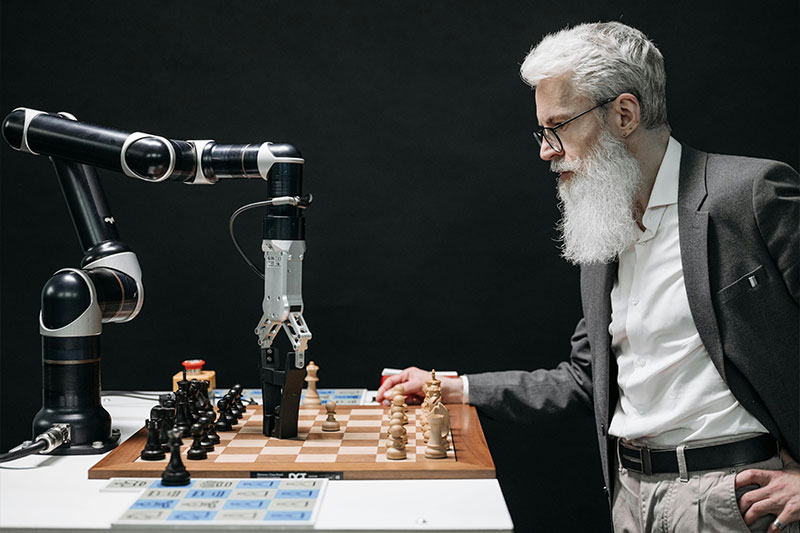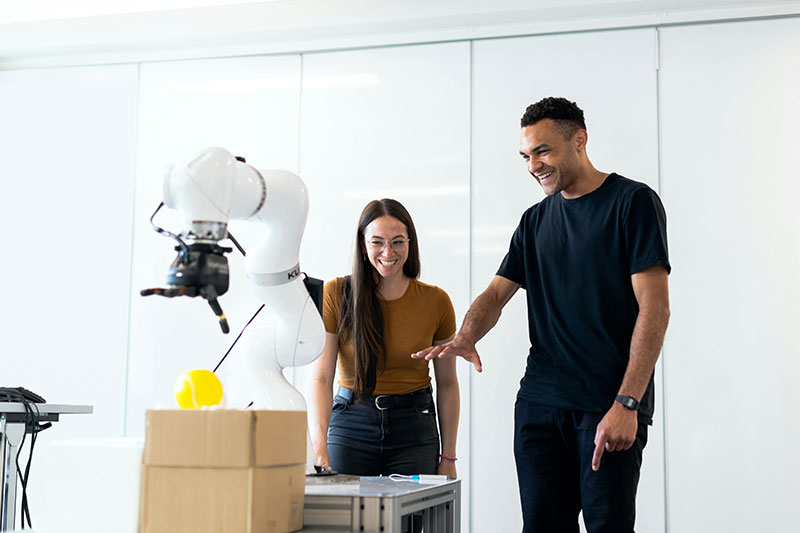We’re very much living in a time where artificial intelligence is increasingly finding its way into how we go about our everyday lives. Of course then, the topic of human and AI collaboration has emerged as a frequently raised topic of discussion. Balancing the remarkable capabilities of technology with the nuances of genuine human connection is going to be essential for creating a future where humans and machines can both thrive.
The key to success with AI is human-machine collaboration, where AI tools are designed to complement rather than replace human efforts, ensuring that creativity and personal insight are still given space to flourish. This article looks at how collaborative intelligence—humans and AI joining forces—can be harnessed effectively, focusing on enhancing transparency, trust, and the ever-important human touch in our interactions as society moves forward with this amazing technology.
Enhancing Human Tasks with AI
AI should ideally be designed to work alongside humans, enhancing rather than automating tasks that require creativity and originality. In such a complementary relationship, AI can handle repetitive or data-intensive tasks, freeing up humans to focus on creative thinking and problem-solving. As an example, AI tools could be used in design to generate colour palettes or layouts, allowing designers to concentrate on what makes design human – the artistic vision and personalisation potential.
Similarly, in writing, AI can assist with grammar checks or content planning and structuring, while humans step in to inject personality and style. A collaboration like this ensures human intuition and emotion are preserved, and this is so important because machines are not currently capable of replicating these qualities. By making the most of AI’s capabilities, humans can concentrate on pushing the boundaries of creativity, exploring innovative ideas that have previously been dampened by time-consuming tasks. When machines can be deployed to complete repetitive and dull tasks, human imaginations can soar and people can dream big.
Automation Still Needs Human Insight
While automation can significantly boost efficiency, it’s still important for human supervision to ensure accuracy and fair results. While AI is next level efficient at processing large volumes of data and identifying patterns, it lacks the contextual understanding and emotional intelligence that humans possess. Therefore, humans are still very much needed to to interpret AI-generated data and check accuracy to make informed decisions. To give a simple example, in healthcare, AI can quickly analyse medical images, but a doctor’s expertise is still vital for diagnosing and treating patients. Just as in customer service scenarios, AI might be able to efficiently handle routine inquiries, but complex issues still need the empathy and judgement of a human. When businesses see that they can combine the analytical capabilities of AI with the nuanced understanding of humans, they can provide more streamlined and comprehensive service solutions to their clients. Taking a balanced approach ensures automation doesn’t overshadow the invaluable experience, emotion and insights humans bring to the table. After all, people still want to know they are dealing with people.
The Importance of Personal Connections
In the age of AI, maintaining personal connections is more important than ever. While AI can facilitate communication, the human touch is crucial for building and maintaining genuine relationships. Of course AI systems lighten the load by providing data insights or managing logistical details, but humans are still needed to provide meaningful interactions. In the education sector it’s often questioned whether students will ever be taught entirely by robots. I’d like to think not, because while AI can track student progress and generate learning material it isn’t able to replace ever-important teacher – student personalised interactions. The great advantage of AI in education is freeing up educators to support students with more one-on-one or small group attention.
The issue of trust surfaces here and it’s important to ensure we’re clear about AI’s role in our interactions. Clearly indicating when we’ve engaged AI helps maintain authenticity and this is going to become increasingly important as AI moves further and further into the mainstream and our every day.
People Hate Feeling Misled
Building credibility involves being transparent about the role of artificial intelligence in various interactions. When people aren’t sure whether they’re engaging with a person or a machine it can lead to doubt and mistrust. Therefore, clearly identifying AI’s involvement in any communications is crucial. For instance, chatbots should disclose they’re machine generated at the beginning of an interaction, allowing users to adjust their expectations. For example, a simple statement such as “You are now chatting with an AI assistant” can inform users immediately and mitigate any potential concerns about authenticity.
Additionally, when AI is used to generate content, it should be communicated clearly to those reading. And in walking the talk, yes AI has assisted with my writing of this article. A large language model proposed an outline for this piece as well as assisted with grammatical suggestions to enhance expression and readability.
Encouraging conversations about how AI is implemented and its impact on various processes can lead to improved understanding and acceptance. Businesses should invite feedback from users, allowing customers to express concerns or suggestions regarding AI interactions. A feedback loop like this could help identify areas where AI can be improved or where it’s perceived transparency may be lacking. Open communication also demystifies AI technology, reducing apprehension and building confidence in its applications.
Ultimately, humans should make a commitment to being honest about AI’s capabilities and limitations, and how they are using the technology.
Maintaining the Human Touch
While technology can efficiently handle tasks, the human element is what evokes real emotions. The importance of personalisation and emotion is key to maintaining customer satisfaction and loyalty.
Businesses shouldn’t focus on replacing human interaction, but augment it with automated processes that enhance the overall experience. This means incorporating AI in a way that complements and supports human touch, rather than replacing it entirely.
Incorporating Personal Stories
Incorporating personal stories into AI-enhanced content can significantly enhance the human touch. Stories have long held incredible power to evoke emotions and create connections, which are essential for meaningful communication. When AI is used for customer service or in content creation, weaving in personal anecdotes can add personality and relatability. For instance, an AI customer service representative can share relatable anecdotes when responding to a customer’s inquiry. Similarly, AI-generated content can be personalised by integrating user-provided stories, making it feel more tailored and genuine. Personal stories add depth and personality to otherwise impersonal interactions, bridging the gap between technology and human warmth.
Creating Engaging Experiences
To create engaging experiences when using AI takes skill and knowing how to merge technological innovation with human creativity is almost a specialist area of its own. For virtual interactions to remain captivating, AI systems need to be programmed to adapt to user preferences and so as to provide dynamic personalised experiences. Analysing user data to identify habits and trends can be used when tailoring content, recommendations, or interactions that connect with individual users. Adding multimedia elements, such as visuals and audio, can make AI-driven experiences more dynamic and appealing, too. Ultimately though, the key to maintaining engagement lies in the balance between automation and human input. Human guidance of AI ensures it remains aligned with user expectations and can adjust to cultural and emotional nuances as needed.
Strategies for Effective Human and AI Collaboration
Collaborative intelligence, where humans and AI work hand-in-hand, is the most impactful approach to problem-solving and innovation. The brings together the best of both worlds and allows each to leverage their strengths—AI can show off its ability to process data rapidly and humans’ capacity for creativity and critical thinking is harnessed. In short, AI should handle tasks that benefit from automation, such as data analysis and routine operations, while humans focus on strategic decision-making and interpersonal interactions.
Training and ongoing upskilling will also be vital, so that humans remain able to interpret AI insights and emerging tech developments in order to apply them effectively. Staying agile in a rapidly changing technological landscape will be more important than ever and committing to collaboration (rather than competition) between humans and AI, will allow businesses to unlock unprecedented levels of productivity and creativity.
Looking Forward as the Human-Machine Collaboration Evolves
Future AI success will lie in its integration as a complement to human capabilities rather than a replacement for them, so that AI systems enhance human strengths and compensate for weaknesses, creating a balanced partnership.
Successful integration also needs to focus on ensuring user-friendly interfaces and intuitive interactions, so that the technology is accessible and efficient for all. Continuous feedback loops are essential, so that humans can continually refine AI applications and ensure they meet evolving needs. If we can create an environment where AI is seen as an ally in achieving business objectives, performance and innovation can be optimised. Ultimately, the success of AI is going to hinge on its ability to enhance, rather than disrupt, human workflows.
Our world is only going to be increasingly influenced by digital interactions, so this makes it more important than ever to concentrate on preserving genuine human connections. What commitment can we make to ensure we maintain the human touch and leave AI to do what it does best? Let’s find out by continuing to discuss AI, exploring its potential, addressing concerns, and discovering new ways to work with it for a better tomorrow.






